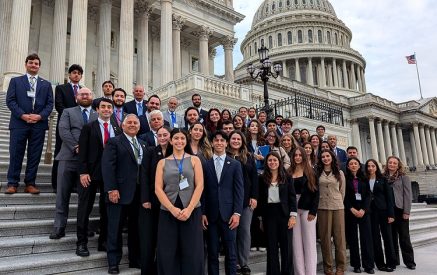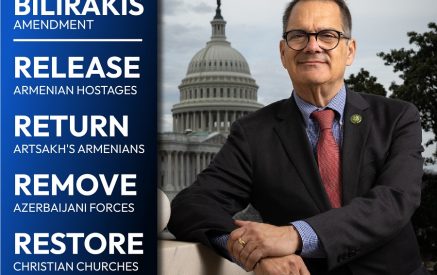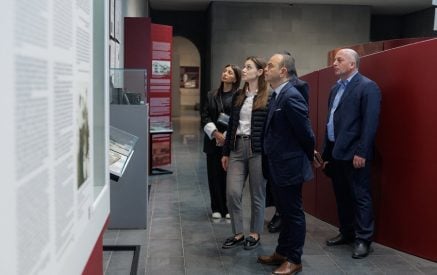ԵՌԱԳՈՅՆ. In honor of Mother’s Day, the Armenian National Committee of America (ANCA) Eastern Region compiled a list of 36 Armenian women who inspire and empower them in their daily lives – in Hai Tahd, at home and at work. The inaugural photo essay, now expanded into a series of articles, will cover the initial 36 women and several more. The dynamic women – past and present – that will be spotlighted in this series include revolutionaries, poets, authors, scientists and elected officials to name a few. Featuring these women of different decades and varying backgrounds, paints the story of the Armenian woman – strategic, fierce and resourceful. Many of them are legendary and although they faced circumstances of varying degrees, they are all united in the fact that they have contributed significantly to the Armenian nation, the Diaspora and the work of Hai Tahd.
In light of the 102nd anniversary of the First Republic of Armenia, it is only right that our first chapter start with the story of Berjouhi Parseghian, Katarine Zalian-Manoukian and Varvara Sahakian.
Parseghian, Zalian-Manoukian and Sahakian were the first three women to serve as parliamentarians during the First Republic of Armenia in 1919. Still reeling from the aftermath of the Armenian Genocide, the collective dream of an Armenian nation-state was realized with a declaration on May 28, 1918. The Armenian Revolutionary Federation’s (ARF) herculean efforts despite layers of challenges allowed the First Republic to flourish.
Under the leadership of Aram Manougian, the man who is universally accepted as the father of the Republic of Armenia, the Republic was a well-organized democratic state that featured an unprecedented progressive constitution – an incredible feat considering the Republic had endured 600 years of subjugation. Long before many western nations, the Republic gave women the right to vote, created a multi-party parliament comprised of 80 members and elected three women parliamentarians.
Read also
The trifecta of female leaders – one a pedagogue and the two others physicians, all three humanitarians – served as parliamentarians, earning their right on this list of Armenian women who inspire. In 1918, when women in the US were only just advocating for the right to vote, these three women had taken on leadership roles and were involved in decisions that would not only shape the future of the Republic of Armenia, but also the Diaspora.
Berjouhi Parseghian, a teacher, writer and humanitarian, began her career as a teacher in Van and Giresun. In 1909, she married Sargis Barseghyan who served as the leader of the ARF in Constantinople. After he was executed as one of the intellectuals first targeted by the Ottoman Turks during the Genocide, she took their son and fled to Bulgaria. However, she soon resettled in Tbilisi and resumed teaching at St. Gayane Girl’s School and later at Mariamian-Hovnanian Girl’s School, both Armenian schools located in the capital of Tbilisi.
She accomplished some of her most admirable work while in exile in Paris for the Nansen International Office for Refugees, which was established in 1930 by the League of Nations and helped place refugees from the war torn areas during the period between 1930 and 1939. Parseghian focused her efforts on assisting Armenians displaced by the Armenian Genocide.
A woman of many talents, Parseghian’s literary contributions—Arpik, One Ring Chain and Days of Distress—were recognized by American anthologist Edward J. O’Brien.
More than anything, Parseghian believed in universal suffrage. As a public servant, she worked with members of the ARF to ensure that the constitution of the First Republic provided these opportunities for women. Alongside her fellow female colleagues in parliament, she helped provide orphans and refugees with the care they desperately needed.
Parseghian’s female counterpart in parliament was Katarine Zalian-Manougian—the wife of Aram Manougian, the leader of the First Republic of Armenia. The two met when she was working as a doctor at an orphanage in Yerevan. They were married in 1917, and a year later she gave birth to their only daughter Seda. In 1919 she was elected to the parliament where she served beside Parseghian and Sahakian.
Following her husband’s death and the Bolshevik takeover of Armenia, she fled to Krasnodar, Russia, and then later returned to Soviet Armenia in 1927 to fill the void of physicians in the country. She died in 1965—a devoted physician focused on orphans and migrants, a member of the ARF and the Health Committee of the Parliament of the Republic of Armenia.
Varvara Sahakian was the third female parliamentarian elected to serve during the First Republic of Armenia. Also a physician, Sahakian served as the speaker of the first convocation of the Parliament and was elected as the deputy of the second convocation.
During the February Revolutions, she was forced to flee on foot to Iran, Iraq and later to Lebanon. She witnessed several losses in her life; one son died due to the absence of necessary medicine and the other died in 1932. Her husband Avetik Sahakian was imprisoned and later died during the Sovietization of Armenia.
Despite her tragic life story, she was a leader in the development of educational programs and was involved in social service including the work of the Armenian Relief Society (ARS).
These women worked in partnership with the ARF in the governance of Armenia’s First Republic. They led lives filled with hope, fear and love for their country, their families and the people they served. As members of the inaugural parliament of the 1918 First Republic, they served alongside leaders who granted citizens universal suffrage, adopted more than 1,000 laws and legal documents and created laws relating to the inner and foreign policies of the Republic.
Berjouhi Parseghian, Katarine Zalian-Manoukian and Varvara Sahakian – we thank you for your service to the Armenian nation and people. As we reflect on May 28, may we remember our heroes whose task was accomplished albeit with enormous challenges. They not only led the First Republic, they instilled in the Armenian people a sense of hope amidst adversity.
The ANCA Eastern Region invites you to continue to follow us on this journey of exploring the powerful women – past and present.




























































